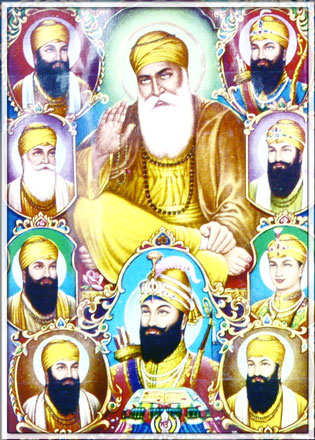|
| |
MEANING OF KHALSA |
THE MEANING OF KHALSA |
|
|
| The term “Khalsa” is a modifed form of Urdu word “Khalis” which means ”pure”. In the context
of the Sikh History, it is interpreted to mean “pure faith” or a “pure person”. In 1969,
on the day of Baisakhi , Guru Gobind Singh, the tenth guru of the Sikhs, laid the foundations of
Khalsa Panth(not of Sikhism as sometimes misunderstood). When he was still young, he saw
the persecution of the Hindus by the Moughal Government. The Hindus sufered under the
yoke of religious and political tyranny. Even his own father, Guru Teg Bahadur, was put to death
in Delhi. Guru Gobind Singh realized that a very serious situation was facing the Sikhs and their
faith which was preached by Guru Nanak and other Sikh Gurus. He believed that their faith
was in danger and could be destroyed.
He started to prepare himself for the life’s struggle and stayed for a number of years at a
place called Paonta where he was able to meet pundits from Patna and Benaras.
During this period not only did he become a Punjabi, Hindi and Sankskrit scholar, but
trained himself as a great fghter. As soon as he became confdent that he would be able to
unite his followers into a disciplined, militarylike organization, he came to Anand Pur. |
|
 |
| On the day of Baisakhi in 1699, there was a big gathering at Anand Pur ,
where in a special ceremony
Guru Gobind Singh baptized fve persons in his own way who had already been tested of
their loyalty a day earlier. He called them “Panj Pyaras”(The beloved fve) and gave them “Amrit”
(nectar) which he had prepared in that ceremony. Later he himself drank from them.
The word “Singh” (meaning lion) was added to the names of the fve baptized and the guru himself
changed his name from Gobind Rai to Gobind Singh. |
|
# |
Name |
Guruship on |
| 1 |
Guru Nanak Dev |
April 15, 1469 |
| 2 |
Guru Angad Dev |
September 7,1539 |
| 3 |
Guru Amar Das |
March 25,1552 |
| 4 |
Guru Ram Das |
August 29,1574 |
| 5 |
Guru Arjan Dev |
August 28,1581 |
| 6 |
Guru Hargobind |
May 30,1606 |
| 7 |
Guru Har Rai |
February 28,1644 |
| 8 |
Guru Har Krishan |
October 6,1661 |
| 9 |
Guru Tegh Bahadur |
March 20,1665 |
| 10 |
Guru Gobind Singh |
November 11,1675 |
|
| |
Then other Sikhs, who were present in
the assembly, had “Amrit and became part of the new brotherhood created by Guru Gobind
Singh that day. A new code of conduct was prescribed for all Sikhs. Guru Gobind Singh that day. A new code of conduct was prescribed for all Sikhs.On that day a new
spirit was infused into thousands of his followers and the foundations of Khalsa Community,
which was later on refered to as Khalsa Panth in the history books of the Sikhs, were laid.
From that day Khalsa Panth became a kind of order which Guru Gobind Singh established to
fight against the tyranny of the Moughal Government and to meet the growing hostility of
the Rajas of smaller Hindu states of Punjab.All his followers were expected to be soldiers as
well as saints. He taught them a new concept of ‘Bhagti’ and ‘shakti’(Bhagti means devotion to
god and shakti power to fght) and told them to become brave and fearless like lions. They
were to shun timidness, feelings of weakness and defeatist attitude. Gambling ,theft,
hypocrisy, falsehood were condemned and the use of tobacco and intoxicants was prohibited.
They were asked to become honest workers and to rise against all those who indulge in
exploitation of other men. He preached that all men are equal in the eyes of god and caste
prejudices, therefore, are not to be displayed.
All those who joined the Khalsa Panth were re-quired to have long, uncut hair, a comb, a pair
of shorts, an iron bracelet and a sword.This is how the KHALSA was born in the
seventeenth century on the day of Baisakhi.It is best described as an order, as a society
possessing a religious foundation and a military discipline.
The Khalsa community has undergone an evolutionary process. As it is known today, it is a
product of many years. The wheels of history have made the term “Khalsa” more compre-
hensive and are being used in a wider sense now.
Although an ofshoot of Hinduism, it has become a distinct community from Hindus, hav-
ing diferent ways of worship and social ceremonies |
| |
|
|
|